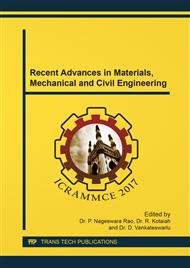p.299
p.305
p.313
p.320
p.327
p.335
p.341
p.347
p.354
Optimisation of Header of a Compact Radiator
Abstract:
The performance of a Plate fin radiator in terms of heat transfer rate and coolant side pressure drop depends significantly on the distribution of coolant through its passages. Uneven flow through the passages i.e. flow maldistribution, can cause local hot spots in the radiator due to high coolant flow in some passages. The flow maldistribution among the passages can be reduced to a large extent by proper optimisation of the header. The present paper investigates the method to optimise the header of a 680 kW radiator to reduce the maldistribution in its passages using Computational Fluid Dynamics (CFD). The analysis was simplified by considering the porous media instead of simulating the exact fin configuration in the radiator. The maximum and absolute values of flow maldistribution factor were considered in this study to determine the effectiveness of the header with respect to flow maldistribution. The flow maldistribution factor was determined based on the individual velocity of coolant in a passage and the average velocity of coolant in all the passages. The methods used for optimisation were rounding the header inlet, tapering the header partially, changing the position of the taper and modifying the end portion of the header. In this paper two parameters, viz., flow maldistribution parameter and absolute maldistribution parameter were considered to measure the maldistribution of a radiator. Due to these optimisations in the header, the maximum and absolute values of maldistribution reduced up to 18% and 45% respectively.
Info:
Periodical:
Pages:
327-334
Citation:
Online since:
February 2018
Authors:
Keywords:
Price:
Сopyright:
© 2018 Trans Tech Publications Ltd. All Rights Reserved
Share:
Citation:


